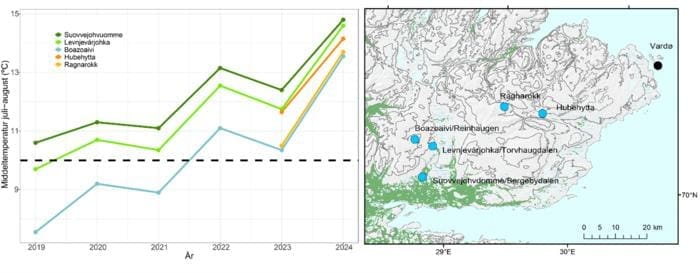Recent data from the Climate-Ecological Observatory for Arctic Tundra (COAT) suggests that conditions in the tundra regions of Svalbard and East Finnmark are becoming increasingly suitable for tree growth, signaling unprecedented climate shifts.
For two consecutive years, COAT’s weather stations in these areas have registered temperatures and seasonal conditions that meet the criteria for forest establishment. However, despite favorable conditions, significant tree growth on the tundra may still be centuries away.

In a notable event, Longyearbyen’s average July temperature exceeded 10°C last summer, surpassing the threshold that typically categorizes polar climates and excludes the possibility of tree growth.
This year, COAT stations recorded even higher temperatures across Svalbard and East Finnmark, where barren mountain peaks on the Varanger Peninsula at a latitude of 70°N experienced temperatures 3-4°C above the 10°C polar threshold.
Such anomalies are not attributed to random fluctuations. Analyzing weather data from 1991 to 2020, COAT researchers noted that the August 2024 temperatures recorded in Vardø (Eastern Finnmark) and Longyearbyen would be expected only twice in 1,000 and ten million years, respectively, under typical climate conditions.
These findings strongly suggest that climate change is responsible for the extraordinary summer temperatures observed over the past two years.
In addition to the classical 10°C threshold, recent studies have refined the criteria for tree growth based on the length and temperature of the growing season. Specifically, for tree growth, a region’s growing season must include at least 94 snow-free days with daily temperatures above 0.9°C, and an average seasonal temperature of 6.4°C or higher (Paulsen and Körner, 2014).

In both 2023 and 2024, these criteria were met at all COAT weather stations on the Varanger Peninsula, with similar trends observed in Svalbard.
High-altitude stations in these areas displayed remarkable temperature increases. At Reinhaugen/Boazoaivi, located within the low-Arctic tundra on the Varanger Peninsula at 470 meters above sea level, the growing season spanned 104 days with an average temperature of 12.0°C. On Svalbard’s high-Arctic tundra, the Nedre Sassendalen station recorded a 102-day growing season with an average temperature of 7.3°C.
Despite these warming trends, the transformation from tundra to forest may be gradual. Climate records reveal that even with temperatures suitable for tree growth, it can take centuries for forest ecosystems to fully establish. The slow pace of forest encroachment is partly due to competitive plant species that adapt more rapidly to climate changes, thereby hindering tree seedling establishment.
Additionally, certain organisms, such as moth species that feed on trees, could delay or even reverse forest expansion under warmer conditions. COAT researchers have documented an increase in crowberry and other plant species that impact tundra ecosystems in Finnmark, alongside large moth outbreaks that pose further obstacles to forest development (Tuomi et al., 2024; Vindstad et al., 2019).

Given the rapid and often unpredictable shifts in Arctic ecosystems, COAT has implemented a comprehensive network of sensors and monitoring stations that continuously track ecosystem responses to warming. This “ecosystem-wide observation system” allows for close collaboration between scientists and biodiversity managers, supporting climate resilience in northern ecosystems and providing early indicators of emerging climate impacts (Ims and Yoccoz 2017).
By documenting these ecological changes, COAT aims to strengthen climate preparedness in the northern regions and anticipate challenges posed by ongoing warming.
***
Find weather and climate data from COAT and MET weather stations here:
Seklima at the Meteorological Institute: https://seklima.met.no/observations/
Reinhaugen on Yr: https://www.yr.no/nb/historikk/graf/1-323916/Norge/Finnmark/Nesseby/Reinhaugen
Nedre Sassendalen on Yr: https://www.yr.no/nb/historikk/graf/5-99882/Norge/Svalbard/Nedre%20Sassendalen
Journal Reference:
Paulsen, J., Körner, C., ‘A climate-based model to predict potential treeline position around the globe’, Botany 124, 1–12 (2014). DOI: 10.1007/s00035-014-0124-0
Tuomi, M.W., Utsi, T.A., Yoccoz, N.G. et al. ‘The increase of an allelopathic and unpalatable plant undermines reindeer pasture quality and current management in the Norwegian tundra’, Communications Earth & Environment 5, 414 (2024). DOI: 10.1038/s43247-024-01451-2
Vindstad, O.P.L. et al. ‘Can novel pest outbreaks drive ecosystem transitions in northern-boreal birch forest?’, Journal of Ecology 107, 3, 1141-1153 (2019). DOI: 10.1111/1365-2745.13093
Ims, R.A., Yoccoz. N.G. ‘Ecosystem-based monitoring in the age of rapid climate change and new technologies’, Current Opinions in Sustainability 29, 170-176 (2017). DOI: 10.1016/j.cosust.2018.01.003
Article Source:
Press Release/Material by UiT The Arctic University of Norway
Featured image credit: Jakob Iglhaut




